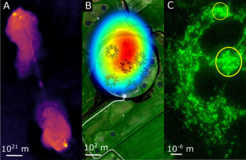Radiation biology, radio astronomy and cosmic rays using information field theory
What do radiation biology, radio astronomy and cosmic ray measurements have in common? For one thing, radiation occurs in all of them. For another, all of these fields are explored using large-scale research facilities and require intelligent algorithms to visualize the quantities that occur in the process. In order to advance this imaging in an interdisciplinary way, the Federal Ministry of Education and Research (BMBF) is now funding the project "Information Field Theory for Experiments at Large-scale Research Facilities". Seven German universities, the Max Planck Institute for Astrophysics (MPA) and Erium GmbH, founded by former MPA students, are involved.
The measured values from large-scale research facilities, such as radio telescopes or particle detectors for cosmic radiation, are not directly accessible to human interpretation or even to the eye alone. Often, these data must first be translated into images using complex computing procedures, which can then be interpreted by humans. So far, these procedures have been developed individually for each instrument. But the underlying question is actually the same, namely "What did the measured quantity originally look like?" The measurement principles of the respective instruments and the properties of the quantities measured with them differ considerably in practice, but from a theoretical point of view these differences are only mathematical details.
To standardize such imaging methods, the research group of PD Dr. Torsten Enßlin at MPA has developed the Information Field Theory (IFT) for spatially varying quantities. The theory describes how an accurate image of these fields can be generated from measurement data and our prior knowledge of physics. Thus, the IFT provides possible images of these quantities and, at the same time, information about the remaining uncertainties of the fields thus reconstructed.

Application areas of the information field theory imaging methods developed in ErUM-IFT: A) radio astronomy, B) radio detection of air showers triggered by cosmic ray particles of high energy, and C) cell biological microscopy. Although the typical lengths of the systems involved (see markings) differ by a factor of 10²⁷, information field theory allows their reconstruction using the same methodology.
Originally, information field theory was developed for astrophysical measurements. However, it is so general that it can be used for any measurement of field-like quantities. Within the framework program 'Exploration of Universe and Matter' (ErUM) the project 'Information Field Theory for Experiments at Large Scale Research Facilities' (ErUM-IFT) is now funded. The aim is to solve exemplary imaging problems for some large-scale research facilities. IFT-based algorithms for radio astronomy and their visualization are being developed at the University of Bielefeld, the University of Hamburg and the Technical University of Munich; at the RWTH Aachen University, the Friedrich-Alexander University Erlangen-Nuremberg and the Karlsruhe Institute of Technology, IFT methods are being used for the detection and analysis of radio pulses caused by cosmic rays. In addition, IFT-based methods for three-dimensional imaging of biological samples are being developed at the Universität der Bundeswehr München. At the Max Planck Institute for Astrophysics in Garching, basic IFT methods are being developed that are needed in the applications.
The phenomena investigated in the ErUM-IFT project have very different length scales (see figure) but can still be analyzed with the same methodology. The individual resulting applications will not only be exchanged between the subprojects and other ErUM projects, but will also be made freely available to the general public as open-source software. At the same time, Erium GmbH will explore their industrial potential.
The spokesperson of the alliance, PD Dr. Torsten Enßlin, explains "The methodologies for information field theoretical imaging developed in this project should also be transferable to other areas. The requirements for methods in medical imaging or geophysics, for example, have many similarities to those in radio interferometry and microscopy. Therefore, the application of information field theory is not limited to large-scale research facilities, but is already feeding into these fields."












